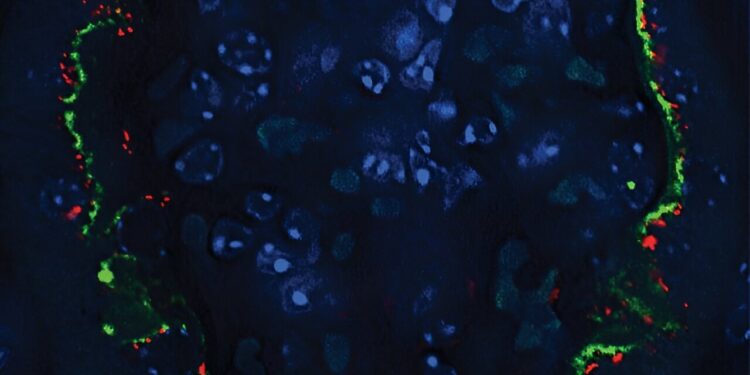Immunofluorescence image of the proximal tubule (in green), surrounding the glomeruli of the kidney with activated calcium/calmodulin-dependent protein kinase 1 (CaMK1D), in red. Blue indicates kidney cells. Credit: Sandeep K. Mallipattu and Nehaben A. Gujarati
New research led by nephrology specialists at Stony Brook Medicine, focused on targeting key cell signaling between two kidney cell types and inducing a certain gene within these processes, could help prevent or to reduce the progression of diabetic kidney disease (DKD), the leading cause of chronic kidney disease worldwide.
According to the National Kidney Foundation, about 1 in 7 adults in the United States have kidney disease, or more than 35 million people. Up to a third of all Americans with diabetes have kidney disease.
Nephrology researchers have yet to create a therapeutic approach to reverse or prevent the progression of DKD. Sandeep K. Mallipattu, MD, and Nehaben A. Gujarati, PhD (lead author), of the Division of Nephrology and Hypertension, Department of Medicine, Renaissance School of Medicine at Stony Brook University, hope that their mouse model constitutes a first step towards a new, more effective therapeutic strategy against DKD. Their findings are published in Natural communications.
They used a multiomics approach (genome, proteome, etc.) to demonstrate that induction of a human KLF6 transcription factor and targeting cell signaling between podocytes and proximal tubule cells attenuates podocyte loss, proximal tubule dysfunction and possible interstitial fibrosis that occurs in later stages of the disease.
Podocytes play a central role in regulating glomerular function, the filtering process that removes waste and excess water from the blood and forms urine. Proximal tubule cells, the predominant cell type in the kidney, perform many functions such as reabsorption of water, glucose, and some proteins from the glomerular filtrate and also maintain electrolyte balance and fluid homeostasis. These two types of kidney cells are essential for preventing the progression of DKD.
Mallipattu and Gujarati demonstrated in this DKD model that KLF6 triggers the secretion of apolipoprotein J (ApoJ) by podocytes, to prime proximal tubule cells by activating calcium/calmodulin-dependent protein kinase 1D (CaMK1D), thereby preventing mitochondrial damage and stopping DKD processes. .
“This cell-to-cell communication via this signaling mechanism in the kidney could serve as a protective mechanism in the early stages of DKD,” says Mallipattu, DCI-Leibowitz Professor of Medicine and chief of the Division of Nephrology and Hypertension .
This study involved a combination of mouse models, human cells and tissue from human kidney biopsies from patients with DKD at different stages.
“In combination, the results of these studies highlight that targeting podocyte-proximal tubule signaling by enhancing apolipoprotein J-CaMK1D could prove to be a therapeutic strategy to slow or even prevent DKD,” adds Mallipattu .
Gujarati and Mallipattu will continue to test this approach to treating DKD. The next step in their research is to determine whether pharmacological approaches to activate this signaling pathway in the kidney could prevent people with diabetes from developing DKD.
More information:
Nehaben A. Gujarati et al, Podocyte-specific KLF6 primes proximal tubule CaMK1D signaling to attenuate diabetic kidney disease, Natural communications (2024). DOI: 10.1038/s41467-024-52306-5
Provided by Stony Brook University
Quote: Induction of a gene that informs cell signaling could stop diabetic kidney disease, study finds (2024, October 10) retrieved October 10, 2024 from
This document is subject to copyright. Except for fair use for private study or research purposes, no part may be reproduced without written permission. The content is provided for informational purposes only.



